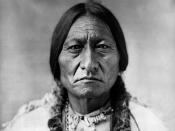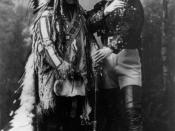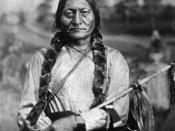A Hunkpapa Lakota chief named Sitting Bull and the history of the Lakota nationhood was the chosen subject of Gary C. Anderson to write a biography on. Although most of the history about Sitting Bull took place back in the eighteen hundreds, Anderson did not come out with his book tell around 1995. Addison-Wesley Educational Publishers published the book in 1996. The book follows the history of Sitting Bull and the native Indians fight with the "white man" over land.
The first chapter goes back in history and sets up the story and setting. It was the eighteenth century and the Americans were beginning to invade the lands west of the Mississippi River. This caused problems because even though Americans saw the lands as an unoccupied region, Sitting Bull and his Lakota or Sioux people knew it as their homeland. While the Indians were living their normal lives by hunting and following the buffalo, the Americans were moving out west and fast.
They established a railway and were on the move for gold. The buffalo population was rapidly decreasing because they interfered with the railroad and the Americans were killing them. This dramatic decrease of buffalo caused a struggle for the Indians because buffalo was their main supplier for resources like food, clothing, and shelter.
After the discovery of gold in the Black Hills both Indians and American were killing each other in small battles over the land that was sacred to many tribes and the Lakota's "owned". The government noticed this and set up The Fort Laramie Treaty of 1968. This meant the areas were placed off-limits to white setters. Despite this ban prospectors still rushed to the west. The government efforts in purchasing the Black Hills failed and the commissioner of Indian Affairs later ruled that all Lakota...



Comment
i liked this report, except for the fact that they should be called Native Americans instead of Indians. Just to be politcally correct
3 out of 4 people found this comment useful.